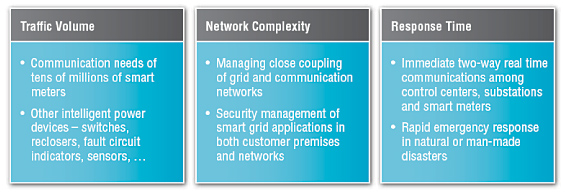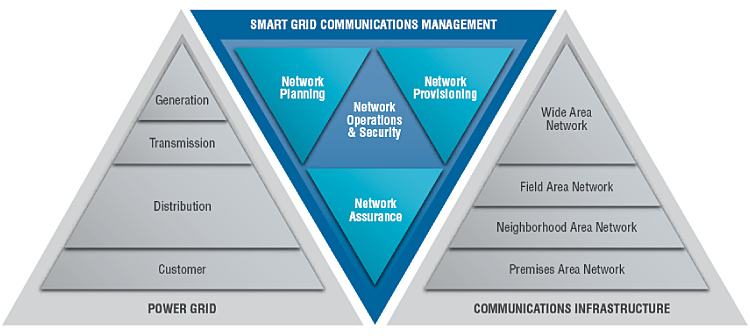When the National Academy of Engineering (NAE) named 20 engineering achievements that had the greatest impact on quality of life in the 20th century, electrification ranked No. 1. Telephony and the Internet ranked 9 and 13, respectively. When the NAE ranks the 21st century’s greatest achievements, it’s a safe bet that electrification, telephony and the Internet will continue to top the list moving and move a step closer to becoming a single category: The Smart Grid.
That outlook is based on two things: the challenge of building smart grids and the benefits for utilities and society when that challenge is overcome. The first step in meeting that challenge is to understand that a Smart Grid is only as smart as the communications network behind it. That fact often gets overshadowed by all of Smart Grid’s bottom-line and end-user benefits – ironic, considering that a reliable, flexible, manageable, scalable and secure communications network is critical for achieving those benefits.
The next step is accepting that the Smart Grid is more of a revolution than an evolution. Implementing the Smart Grid involves a complete transformation of how utilities do business, from how they manage their assets to how they serve their customers.
A prime example is how, over the past century, every aspect of the utility business – including its communications infrastructure and processes – has centered around one-way delivery of services. But that architecture already is steadily changing, as one-way automated meter reading (AMR) gives way to two-way advanced metering infrastructure (AMI) and demand response (DR) systems.
Two-way communications enables key aspects of the Smart Grid, such as distribution automation (DA) systems, which reduce the number of customers affected by anomalies, interruptions and outages by adjusting the direction of power flows. DA systems complement emerging technologies, such as faulted circuit indicators (FCIs) that use cellular or private wireless to report problems directly to the utility’s outage management system. Instead of requiring line personnel to walk around looking for a change in their mechanical or LED indicator, these next-generation FCIs enable utilities to pinpoint and resolve problems quickly and far more cost-effectively.
A New Era of Complexity
As two-way communications become increasingly important for how utilities do business, they face another challenge: selecting and managing disparate communications network technologies supplied by multiple network equipment vendors. These include 2.5G, 3G and 4G cellular, WiMAX wireless in a few cases, SONET/SDH, IP, MPLS and Ethernet.
There will be comparable fragmentation on the communications service provider (CSP) side, too, where utilities likely will use one CSP’s fiber network, another CSP’s copper network and still another CSP’s cellular network, all in addition to their own private wireless network. Utilities that serve a large geographic area will have additional complexity if it turns out that, for example, no single CSP has fiber infrastructure everywhere that they need broadband connectivity. Figure 1 illustrates these and other challenges.

Figure 1: Communications network challenges for the smart grid
The good news is that as daunting as the communications complexity might sound, it’s comparable to what telcos, cable operators, mobile operators and other CSPs have been successfully managing for decades. The secret to that success is to mask the complexity through the use of communications network management software tools and processes, which provide end-to-end network visibility and powerful, user-friendly performance dashboards that convert data into actionable information.
A few savvy utilities – more about them in a moment – have begun leveraging those kinds of tools and processes as they implement Smart Grid. It’s clear that their peers will have to follow suit sooner rather than later. There’s simply no other way to manage a large, complex, multi-technology network.
The Utilities Telecom Council estimates that of over $3 billion that the US utilities spent on telecom in 2011, about $50 million was on network management. That’s around 2 percent. By comparison, CSPs typically spend between 5 and 10 percent annually. That difference shows that utilities should consider more investment in communications network management tools as their communications networks become more complex.
The telecom industry has introduced and optimized operations for multiple communications technologies such as fiber optics, digital transmission, IP networking and wireless over the past few decades. Utilities, however, will be implementing all of these technologies in a much more compressed timeline.
Smart Moves to Build a Smart Grid
To help address the challenge of managing networks comprised of disparate technologies that’s flooded with constantly increasing amounts of data, utilities can leverage many of the telecom industry principles and platforms associated with the communications network management discipline. For example, utilities need the ability to:
- Create a highly accurate database of Smart Grid devices such as FCIs, meters and DR modules, as well their communications network infrastructure. The latter includes both the physical network elements and the logical network assignments, including locations, equipment instances, connectivity, paths and capacity-supporting technologies such as SONET/SDH, Ethernet, leased lines and cellular.
- Automatically and continually compare the deployed network components to the inventory database to identifying and correct discrepancies. As a result, utilities can run lean operations, instead of buying, storing and deploying more than they need, because they now have end-to-end view of their entire communications network.
- Automate the process of commissioning and configuring network devices to avoid the cost, lead time and mistakes that come with manual provisioning.
Unless a utility already has ample hands-on experience operating a large-scale communications network, it should look for assistance from third parties that have that experience. Those partners can help with major tasks such as:
- Network planning and design, including providing architectural recommendations and detailed designs regarding capacity, resiliency, security, configuration and network addressing requirements. The ideal partner also can help develop network equipment requirements and assess RFP responses, as well as support the utility’s technology integration and test plans.
- Business process re-engineering, including staff and leadership, systems, technology and data. This step should include assessments to provide an implementation roadmap for identifying and tracking Smart Grid goals.
- Capital budgeting and asset management, which is key for optimizing the efficiency of the entire Smart Grid entire portfolio from both an operational and financial perspective. The assets should include communications networks, power grid, IT, land and vehicles.
With the evolution to the smarter grid, utilities will have a lot of new and different data to manage. Each intelligent device will have identification, connectivity, configuration, attribution, alarm, performance and other types of data. Tens of hundreds of millions of data records will come from smart meters and machine-to-machine devices. How can utilities collect, store and analyze all of the data that Smart Grid devices are capable of providing?
The ideal network management solution gives utilities the ability to sift through the data, compile key performance indicators (KPIs) in near real-time and instantly push results to a dashboard where managers and executives can quickly assess the health of their network enabling actionable operational decision making. The solution also should provide the insights necessary to make informed business decisions, such as where to deploy additional network resources, how to proactively identify areas of poor communications network performance, and identify potential cybersecurity vulnerabilities and threats before a breach is encountered.
Figure 2 illustrates a holistic approach to looking at the major components of an effective Smart Grid communications management strategy that links the power grid to a secure multi-vendor communications network. It is built on a three-pronged operational foundation: network planning, network provisioning, and network assurance. Overarching all of these are the very important areas of network operations and network security.

Figure 2: System and process focus areas for the design and operation of smart grid communications networks
Implementing a Smart Grid ultimately is an exercise in convergence: of power grid, information technology, and communications infrastructure. To successfully operate this complex triad, a communications network management platform will provide the foundation for convergence and enable utilities to execute their Smart Grid strategies effectively and securely.
Three Success Stories
To appreciate how communications network management enables utilities to successfully develop and execute their Smart Grid strategies, consider the following real-world examples:
- Case #1: An electric utility owns an extensive fiber network that it uses for its internal data communications for managing the power grid. The utility also sells communications network capacity and services to enterprise customers. It implemented a network management platform in order to have a single set of tools for all aspects of the fiber network.
With the platform providing end-to-end network visibility, the utility was able to reduce the time spent identifying failed circuits from hours to minutes. With increased responsiveness, contact center staff and other employees were able to be more productive as outages were able to be identified and repaired more quickly, and less commercial revenue is lost.
- Case #2: Another electric utility owns both a large Ethernet and IP-based fiber network, and a legacy microwave network. One of its first Smart Grid applications is a recently implemented wireless AMI solution. The utility wanted a single, integrated network management platform capable of handling all of these disparate networks, applications and technologies.
This project is noteworthy partly because like most, this utility has telecommunications infrastructure from multiple equipment suppliers. When assessing network management solutions, the shift from multiple single-vendor solutions to a system capable of supporting a multi-vendor network, should be paramount. In addition to operational efficiency and reduced training time, a multi-vendor system provides an end-to-end view, enabling the utility to quickly identify specific points of failure.
- Case #3: A third utility was in the early stages of developing their Smart Grid evolution plan. As part of that plan, they wanted to complete a comprehensive physical and cybersecurity assessment and put in place operational processes associated with on-going management of potential security vulnerabilities and threats. This utility, in conjunction with cross-industry cyber security consultants, developed a comprehensive security architecture, which included assessment, testing and considerations for the wireless networks they were deploying.
As they utilities show, when multi-layer, multi-technology, multi-protocol communications networks are properly designed and managed, the result is a Smart Grid that’s reliable, scalable, secure and cost-effective. In the process, these utilities have completely transformed how they do business, enabling them and their customers to reap all of the benefits that come with what will be one of the 21st century’s great technological achievements.
About the Author
 Ray Bariso has 20 years of management, business and technical experience developing, delivering, selling and managing complex software and services solutions. He has held various roles in systems engineering, solution architecture, consulting, program management & delivery, sales & marketing and product line management. His current responsibility includes managing Telcordia’s Wireless & Smart Grid solutions business, which includes the definition and execution of Telcordia’s overall Smart Grid go-to-market strategy, partner ecosystem development, solution architecture, and business management.
Ray Bariso has 20 years of management, business and technical experience developing, delivering, selling and managing complex software and services solutions. He has held various roles in systems engineering, solution architecture, consulting, program management & delivery, sales & marketing and product line management. His current responsibility includes managing Telcordia’s Wireless & Smart Grid solutions business, which includes the definition and execution of Telcordia’s overall Smart Grid go-to-market strategy, partner ecosystem development, solution architecture, and business management.







